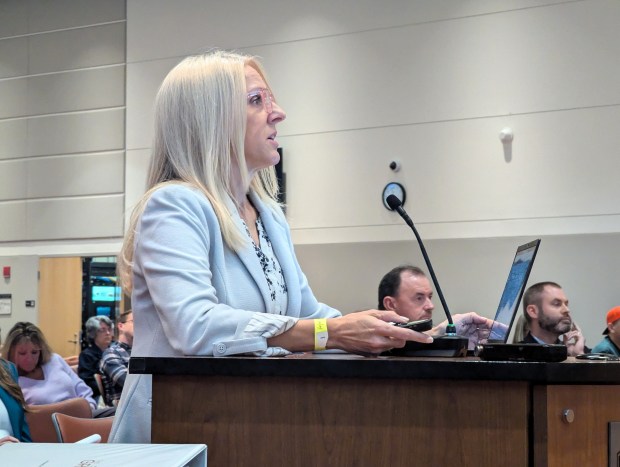In the past week, the Sugar Grove Village Board has spent roughly 10 hours hearing public comments about and discussing the details of a controversial proposed development, and it isn’t over yet.
The proposed 760-acre project is known as The Grove, and developer Crown Community Development says that it could one day hold neighborhoods, townhouses, apartment complexes, a business park with warehouses and data centers, retail businesses, restaurants, a walkable town center and over 200 acres of open space with trails.
Some residents of Sugar Grove and nearby communities, including many who live near the proposed project site in unincorporated Blackberry Township, have regularly voiced their opposition to the project along with their concerns, from the disruption of the area’s rural character to an increase in traffic that could impact public health, among a myriad of other issues they have with the proposal.
Crown Community Development is requesting the 760-acre site, which is located around the Interstate 88 and Route 47 interchange, be annexed into Sugar Grove, zoned under the flexible Planned Development District designation and given a tax increment financing, or TIF, district to help fund infrastructure and site development.
The Sugar Grove Village Board held a public hearing on the annexation of the property and began discussing the project at a regularly scheduled meeting on Tuesday that started at around 6 p.m. and went until 11:30 p.m., when village trustees voted to continue the meeting two days later.
Again on Thursday, the board discussed the project from 6 to 11:30 p.m. and, once again, voted to continue the meeting — this time until this coming Tuesday at 6 p.m.
The meeting up to this point has been held at Waubonsee Community College’s Academic and Professional Center at 4S783 Route 47 in Sugar Grove. It has also been streamed online to the village’s YouTube channel.
Sugar Grove Village President Jennifer Konen said the meeting’s continuation set for this coming Tuesday will either take place in the same location or will be at Village Bible Church, 847 N. Sugar Grove Parkway in Sugar Grove, depending on availability.
The Village Board is not expected to take any action on the project at the meeting’s continuation. Instead, the first time the board is likely to vote on any part of the project is its next meeting on Sept. 3, according to a meeting timeline posted to the village’s website.
The meeting that started on Tuesday is far from the first about the proposed development.
It has previously gone before a Joint Review Board of various taxing bodies that would be impacted by the proposed TIF district, been up for a different public hearing on the proposed TIF district and was the subject of a multi-day Sugar Grove Plan Commission and Zoning Board of Appeals meeting recently that lasted around 12 hours over several days.
However, the meeting which began Tuesday was the first time the Sugar Grove Village Board has discussed the project as a whole. Trustees spent hours going through the three parts of the project, picking apart details and asking Crown Community Development employees for clarifications or concessions.
Sugar Grove trustees first discussed the TIF district proposed to support the project and the proposed redevelopment agreement that would set the responsibilities of both the village and Crown throughout the 23-year lifespan of the district.
TIF districts are allowed under state law to help encourage the development or redevelopment of areas considered to be “blighted” under the state’s TIF Act.
If an area is designated as a TIF district, additional property taxes that come as a result of development within that area are placed into a special fund. Those funds can then be used to improve the area, such as through the construction or improvement of publicly-owned infrastructure.
Crown Community Development’s Jennifer Cowan has previously said the proposed development is not possible without the proposed TIF district. A memo from economic development consulting firm SB Friedman, which was included in the redevelopment agreement, said Crown would be developing the property at a loss if not for the TIF district.
With the proposed TIF district, Crown would be making around a 9.5% profit, according to SB Friedman’s memo.
The memo also projected that the TIF district would generate as much as $340 million in funds that could be used for eligible expenses under state law. Crown Community Development asked for $109 million of that money to do improvements to the land that Cowan has said would benefit the village.
These improvements include mass grading and drainage improvements to help fix downstream flooding, building “backbone” infrastructure like water mains and pumps, building or improving roads, constructing parks and creating trails throughout the property, among other things.
According to the memo, the company is expecting to spend a total of almost $182 million on the proposed development.
Cowan has previously said that the company does not build the final structures of its developments except in the case of promised amenities. They prepare the land and then sell it to builders.
If the Village Board agrees to the proposed redevelopment plan and creates the TIF district, Crown Community Development would not be getting those funds upfront.
Instead, Crown would pay for the construction itself, and after it meets certain conditions laid out in the plan, the village would issue the company a note to pay it back for certain eligible expenses plus interest using TIF-district-generated funds.
Conditions may include a certain number of occupied homes, a certain amount of groundwork completed, or a similar mark of substantial completion.
Also, if the property does not generate enough tax increment to cover Crown’s costs, the village is not on the hook for the rest of the money. Village staff said this is to protect the village and to incentivize Crown to work quickly to get the development built before the 23-year TIF district expires.
Trustees Heidi Lendi and Sean Michels appeared to be against the proposed TIF district. Michels in particular said he was opposed mostly just to the TIF district supporting housing within the development.
Both said they were concerned about whether or not the land was eligible for a TIF district under state law and echoed a number of residents’ concerns along the same lines.
The SB Friedman report that found the property eligible for the TIF district cites a memo by engineering firm EEI that says the property contributes to downstream flooding, meeting the TIF Act’s qualifications to declare the land “blighted.”
However, Lendi and Michels, along with a number of opposed residents, have disputed this report because they said it does not provide enough evidence to prove its claims.
An EEI representative said at the meeting that the determination was made by looking at Federal Emergency Management Agency maps of the area, not by doing surveys or similar physical studies.
Lendi said the land, which is currently farmed, can only be said to contribute to downstream flooding because it is uphill from the watershed. If this land is blighted, then so is a large portion of all farmland in Illinois, she said.
The TIF district proposal in this location appears to be solely for the encouragement of development, not to actually mitigate any issue with the area, so it does not meet the intention of the TIF Act, Lendi said.
Others, including Trustee James White, disagreed with her. White said the mitigation efforts that would be taken because of the TIF district would help fix some of the flooding in the downstream area, making the proposal a good use of the TIF district model.
Trustees and residents opposed to the TIF district also said they had concerns about how the district would impact other taxing bodies.
Of particular concern was the local school district, Kaneland, which some at the meeting said already has financial concerns.
Village staff said that, each year, TIF district funds would pay the total amount it takes the school district to educate each child living in TIF-supported housing, up to a maximum of 25% of the total funds generated by the TIF district. Those funds would be paid before Crown Community Development gets paid back, village staff said.
A similar process would also be in place for the local library district, which would get paid out of TIF district funds each year for those living in the TIF district and using library services, staff said.
All taxing bodies that will be impacted by the TIF district will be able to ask for TIF funds to pay for needed capital improvements if they can prove those improvements are necessary because of growth in the TIF district. This money would also be paid out before Crown gets paid, according to village staff.
In addition to the TIF district and associated redevelopment agreement, Sugar Grove trustees also discussed the development’s proposed Planned Development District zoning. This zoning is different from other zones in the village because all of its standards are unique instead of being already set by village code.
Crown Community Development’s Cowan said the zoning district is needed to remain flexible to market changes. The development’s five areas each have their own zoning standards, some which match the village’s and others which are unique to the project.
Allowed and restricted uses as well as the standards within each area could not be changed unless that change comes back before the Village Board. Cowan said the subdivision of the property into the five areas laid out in the proposed zoning ensures each area’s standards are set in place correctly.
On Thursday, trustees went through the proposed zoning page by page to discuss which uses should be allowed, restricted and require special permission, along with other standards, in each area. They requested a number of changes from Cowan, who agreed to most and said she would follow up about the others.
Likely the most significant change was to a provision allowing Crown to sell a proposed mixed-use area near the proposed town center to primarily residential builders if they do not find commercial buyers within eight years. White suggested that the provision be the longer of eight years or 80% development in area two, which is fully residential, and Cowan agreed.
She also agreed to restrict recycling centers and heavy manufacturing from opening in the business park, which is proposed to be located north of I-88.
Before the trustees discussed the project, around 40 residents of Sugar Grove and nearby communities spoke about the proposed development. Most were against the project and cited many of the concerns residents voiced at previous meetings, including the project’s impact on public health, traffic, public safety, the rural character of the area, taxes because of the TIF district and more.
Many said they were not against development generally, but were specifically against the Crown Community Development proposal primarily because of the business park.
Residents on the north side of the proposed development also said they feel like they are not being heard because they live in an unincorporated area, not Sugar Grove.
The area near where these residents live would be a mixed commercial- and residential-use area and a business park area, which would likely include warehouses and a data center.
The south side of the project, which is closest to the village, would see primarily residential development along with some mixed-use commercial, particularly around the town center area.
While the vast majority of the speakers were against the project, some people spoke in favor of it. At past meetings, nearly everyone who spoke about The Grove proposal was against it.
Those in favor said the project would bring much needed commercial development to the town and would diversify the tax base, helping to fund the village and other taxing bodies like the school district.
Brian Dahl, who is a Sugar Grove resident and is the president of the Fox Valley Building and Construction Trades Council, said he was also in favor of the proposed development because it would bring jobs to many of the area’s union workers.
rsmith@chicagotribune.com





